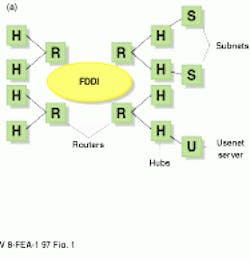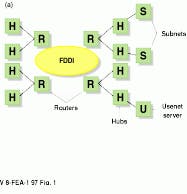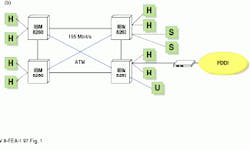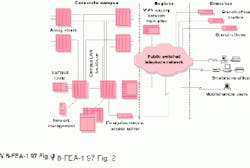FAST ETHERNET CHALLENGES high-speed networks FOR IMAGING APPLICATIONS
FAST ETHERNET CHALLENGES high-speed networks FOR IMAGING APPLICATIONS
By Rick Nelson, Contributing Editor
Designers of machine-vision systems must determine the optimum network topology or combination of topologies to shuffle real-time imaging data from their source to distant image-processing boards and displays. To do so, imaging-system designers can choose from local-area networks (LANs) that handle quality-control data to wide-area networks (WANs) that can transmit medical diagnostic images to remote locations. Because of variable capabilities, no single network topology can suffice for a single image-transmission system. And because replacement of an existing network infrastructure is impractical, compatibility with the installed network is as important as the achievable bandwidths of new equipment.
Networking technologies such as asynchronous transfer mode (ATM), Fast Ethernet, and Gigabit Ethernet are shaping up as the configurations of choice for next-generation imaging-transmission networks. Whereas ATM provides a deterministic, switched connection that guarantees adequate bandwidth for video streaming, the stochastic (probabilistic), high-speed Ethernet topologies do not provide guaranteed bandwidth for real-time, or isochronous, data. However, high-speed Ethernets do provide high bandwidths under light traffic conditions and can build on the installed base of 10BaseT (10-Mbit/s) networks.
Consequently, many imaging-system designers are specifying a middle road by using LAN-emulation and virtual-LAN techniques to mix switched and stochastic technologies. The LAN-emulation technique enables ATM backbone networks to be used with Ethernet workstations. Virtual-LAN techniques allow geographically dispersed users to interact as if they were on the same network and connected to multiple virtual LANs without using more network adapters. In addition, systems integrators need to ensure that networks can interconnect with fiber distributed-data interface (FDDI) and other token-passing-type networks.
ATM connections
For simultaneous voice/video/data operations, IBM Corp. (Research Triangle Park, NC) touts a 25-Mbit/s ATM desktop connection as the ideal LAN solution that provides: video-conferencing at 0.672 Mbit/s; voice operations at 0.064 Mbit/s; MPEG-1 video at 0.6 Mbit/s; and MPEG-2 at D-1 and broadcast-quality D-1 rates (4.5 and 10.5 Mbit/s, respectively), leaving more than 8 Mbit/s for general background data transmission. To accomplish these throughputs, system designers can use Category-3, unshielded twisted-pair (UTP) wiring on 10-Mbit/s, legacy, 10BaseT LANs for a 25-Mbit/s ATM connection.
Although ATM technology faces stiff competition from evolving Ethernet technology at the desktop level, it shows high promise as a backbone-network technology. At one installation, IBM upgraded a LAN by adding a 155-Mbit/s ATM backbone network while using distributed routing to maintain compatibility with the existing FDDI network (see Fig. 1).
Another data-transmission-product company, 3Com Corp. (Santa Clara, CA), also is pushing ATM as a backbone technology. Recently, 3Com used its $5 million MOAT II corporate LAN-to-WAN ATM test network to demonstrate VLAN and interactive high-bandwidth multimedia applications such as just-in-time training and push/pull video streaming technologies. The network consists of ATM network adapters, ATM backbone switches, LAN/ATM switches, access concentrators, routers, and TranscendWare software. These components, in conjunction with traffic generators and video servers, form an emulated LAN, which provides an overlay of virtual circuits for the delivery of voice, multimedia/video, and data traffic in a large, scalable network. The goal is to demonstrate that high volumes of bursty data traffic can coexist with high volumes of multimedia traffic. Complete test results are expected this fall.
Providing real-time video support for ATM technology is Fore Systems (Warrendale, PA). Its television NTSC- and PAL-compliant StreamRunner ATM video products serve applications such as video surveillance, long-distance learning at schools and universities, video conferencing and video distribution for corporations and government agencies, remote court arraignments, and full-motion video and still-image transmissions for medical training and remote diagnosis.
StreamRunner products provide such features as variable Q-factor, which tunes full-motion video quality to meet existing bandwidth limitations; cell-chain technology, which connects multiple video devices to a single, multimode, 155-Mbit/s synchronous optical network (SONET), OC-3c interface, thereby reducing hardware costs; and remote control for TV-like channel surfing and on-screen displays.
Life left for Ethernet
Although Bay Networks (N. Billerica, MA) concedes that ATM will probably be the scheme of choice for applications involving interactivity or streaming video, the company contends that lower-cost, nonswitched configurations will suffice for many applications. Indeed, contends the company, Fast Ethernet at 100 Mbit/s provides four times the bandwidth of 25-Mbit/s desktop ATM under light traffic conditions--that is, when only one node is attempting to access the interconnecting media.
To increase the probability that any node can obtain access within a reasonable time, average Ethernet bandwidth usage typically shrinks to 40% of capacity. Even at that level, however, Fast Ethernet still outperforms 25-Mbit/s ATM by an 8:5 ratio.
Recognizing a need for switched as well as nonswitched topologies, Bay Networks uses Adaptive Networking technology, which aims to provide transparent, scalable access, switching, and network-management techniques as well as Internet protocol (IP) services (see Fig. 2). The technology goal is to support nondisruptive network evolution to accommodate new networking techniques and changing business requirements without sacrificing current operational productivity. Adaptive Networking is embodied in products such as BayStack Ethernet and Token-Ring stackable hubs, BayStack switches such as the BayStack 350 Autosensing Ethernet switch, and the Centillion 100 switching platform, which supports Layer-2 switching for Ethernet, Fast Ethernet, Token-Ring, and ATM connections.
IBM (Research Triangle Park, NC), too, recognizes a need for the interconnection of diverse network topologies. Its 8285 LAN Emulation Server provides legacy networks with transparent access to an ATM network by translating Ethernet or Token-Ring media access control (MAC) addresses into ATM addresses.
Users operating on an emulated-LAN (ELAN) or VLAN network do not have to reside at the same physical location. Taking advantage of this characteristic, the IBM ARTour Emulator Express Network software lets companies extend legacy applications to mobile users over wireless or dial-up networks by providing remote access to the familiar screens and commands of in-office workstations.
Some companies, such as Plaintree Systems (Newton, MA), contend that many networked companies will not migrate to ATM. Nevertheless, they concede that 100-Mbit/s workstations handled by 100-Mbit/s/10-Mbit/s departmental switches can cause congestion on 100-Mbit/s backbones. They also claim that ATM is a high-cost, complex solution to this problem and tout Gigabit Ethernet as the best solution for many sites, which avoids complex-LAN-emulation or packet-translation schemes mandated by ATM connections to legacy networks.
Plaintree addresses migration to Gigabit Ethernet with its WaveSwitch products that offer 1.6-Gbit/s switching capacities while supporting autosensing of 10/100-Mbit/s legacy ports. The WaveSwitch 9200 high-capacity backbone switch can sustain sixteen 1-Gbit/s, full-duplex streams.
Gigabit contender
Another network solution is Myrinet, a higher-than-gigabit-per-second packet-communication and switching network from Myricom (Arcadia, CA). Myrinet differs from other networks by incorporating features such as flow control on every link to accommodate mixed data rates; low-latency, cut-through switches; host interfaces that execute a control program to handle direct interaction with host processes; packet buffering; and network mapping and monitoring. In addition, Myrinet`s aggregate bandwidth can be scaled depending on its configuration.
It can also tie together computers over distances to 35 feet at 1.28 Gbit/s (full duplex) or at half speed at distances to 82 feet. This network technology is defined at the Data Link level (Level 2) of the International Organization for Standardization network reference model by its packet format and steering. At the Network Level (Level 3) and above, Myrinet can carry virtually any type of packet and support many packet protocols simultaneously on the same network. A Myrinet packet-type field can identify the packet payload as an encapsulated IP packet, an encapsulated ATM cell, a packet conveyed by a lightweight protocol, or a Myrinet mapping packet. Because its payload can be of any length, Myrinet supports IP directly, without an adaptation layer, and the protocols above IP, such as transmission control protocol (TCP) and file transfer protocol (FTP).
In addition, Myrinet can provide system-area networking (SAN) and LAN functions. In SAN, Myrinet typically interconnects single-board computers, such as MAP Series VMEbus models from CSPI (N. Billerica, MA; see Fig. 3). Myrinet`s LAN capability can interconnect such systems to development stations and other open architectures such as VME and Sbus.
Ethernet pioneer Digital Equipment Corp. (Maynard, MA) is extending its GIGAswitch and MultiSwitch 900 enterprise switching platforms to support a variety of switching options, including 10-Mbit/s, 100-Mbit/s, and 1000-Mbit/s Ethernet; FDDI; ATM; and IP. According to Digital`s Lynn DeNoia, director of consulting services for strategic networks, "Integration of FDDI and ATM with Ethernet, Fast Ethernet, and Gigabit Ethernet will allow companies to migrate to the network of their choice as each topology evolves."
Steve Kim, president and chief executive officer at Xylan (Calabass, CA), agrees that high-speed Ethernet is the easiest network upgrade. "Inexpensive 10/100-Mbit/s network interface cards are making Fast Ethernet the new standard for workstation LAN connections. And Fast Ethernet is an excellent option for high-speed backbone and server connections," he adds. Xylan is aiming its ESM-100C-12 module at such applications. The module houses as many as 96 fully switched Fast Ethernet ports in a single chassis to bring 100-Mbit/s performance to the desktop. The module is also auto-sensing, enabling workstations to be connected initially at 10 Mbit/s and then upgraded later to 100 Mbit/s.
The ease with which users can integrate 10-, 100-, and 1000-Mbit/s Ethernet components promises a long life for Ethernet networks. In providing guaranteed latencies and bandwidths for applications such as interactive video, ATM is expected to serve as the technology of choice for connecting Ethernet LANs and WANs to desktop nodes for imaging data transmissions.
FIGURE 1. Asynchronous transfer mode (ATM) technology represents a smooth upgrade path for legacy networks, according to IBM. In upgrading a publishing company`s FDDI-based network (a), the backbone was moved to 155-Mbit/s ATM using IBM 8260 switching hubs (b). An IBM 8210 provides interconnection with existing networks.
FIGURE 2. Recognizing a need for switched as well as nonswitched topologies, Bay Networks` Adaptive Networking method aims to accommodate evolving network technologies for corporations, branch offices, home offices, and mobile users linked via the public switched telephone network.
FIGURE 3. Myrinet can serve as either a system-area or a local-area network, tying together computers at distances to 35 feet at 1.28 Gbit/s (full duplex) or at half speed at distances to 82 feet. Here, Myranet`s system-area-network capabilities handle the front panel networking of a CSPI MAP Series VMEbus system, incorporating (a) single-board computers, (b) a MAP-SW-10 SAN/LAN switch, (c) a MAP-2610 PowerPC board, and (d) various PCI mezzanine card (PMC) options. Myrinet`s LAN capability can also connect the target system to a SPARC development station and Myrinet-based Sbus systems.
HIGH-SPEED NETWORKS-a sampling
3Com l Santa Clara, CA l (408) 764-5000 l Fax: (408) 764-5001 l Web: http://www.3com.com
Bay Networks l N. Billerica, MA l (508) 670-8888 l Web: http://www.baynetworks.com/
Digital Equipment Corp. l Maynard, MA l Web: http://www.networks.digital.com
Fore Systems l Warrendale, PA l (412) 742-4444 l Web: http://www.fore.com
IBM Corp. l Research Triangle Park, NC l Web: http://www.networking.ibm.com
Myricom l Arcadia, CA 91006 l (818) 821-5555 l Fax: (818) 821-5316 l Web: http://www.myri.com
Plaintree Systems l Newton, MA l (617) 587-2877 l Web: http://www.plaintree.com
Xylan l Calabasas, CA l Web: http://www.xylan.com




